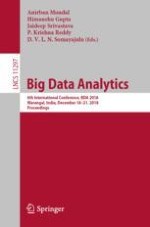2018 | Book
Big Data Analytics
6th International Conference, BDA 2018, Warangal, India, December 18–21, 2018, Proceedings
Editors: Anirban Mondal, Himanshu Gupta, Jaideep Srivastava, P. Krishna Reddy, D.V.L.N. Somayajulu
Publisher: Springer International Publishing
Book Series : Lecture Notes in Computer Science
